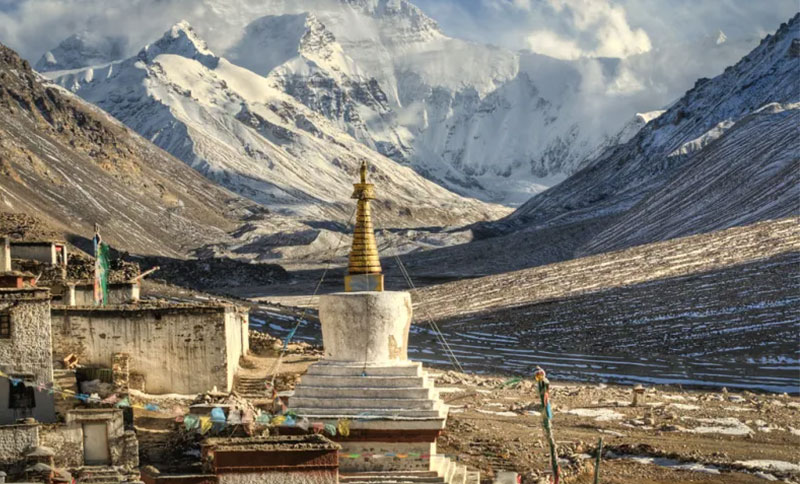This essay won 2nd Place in the 2024 YRIS High School Essay Contest for its response to the following prompt: “Evaluate an example of a foreign policy, historical or contemporary, that can be considered a success.”
Officially, the capital of the Tibet Autonomous Region is the city of Lhasa in Southwestern
China. Legislatively, executively, and judicially, though, the seat of the Tibetan government
lies in the quaint hill town of Dharamshala in India. This “government-in-exile,” as it has been
called, is part of India’s larger policy on China. Although criticised for its Laodicean approach
in falling short of recognising an independent Tibetan state, India’s Tibet Policy has been hailed
as a success for functioning as a bulwark against Chinese hegemony in the region.
Background
On October 7, 1950, the newly founded People’s Republic of China invaded Tibet in an attempt
to expand and consolidate the frontiers of the young nation. By 1954, resistance in Tibet against
the increasingly absolutist Chinese regime had grown and in 1959, the Dalai Lama, the spiritual
and political leader of Tibet, fled to India, never to return. In the backdrop of this political
unrest, Jawaharlal Nehru, India’s first Prime Minister, implemented India’s Tibet Policy that
intended to provide refuge to Tibetans. Domestically, the policy was popular among the public
who believed in the sovereignty of India and its leader post independence in 1948. Globally,
too, the policy gained little to no backlash owing to Nehru’s prominent role as one of the
pioneers of the Non-Aligned Movement. Today, while India does not officially recognise Tibet
as an independent state, India’s Tibet Policy extends shelter to Tibetans as “foreigners” under
domestic law, allows the Tibetan government-in-exile to operate out of Dharamshala under the
Dalai Lama and limits their involvement in Indian politics.
Standing Up to the Dragon
Clashes along the Galwan in 2020 and skirmishes along Arunachal Pradesh in 2022 have
marked a particularly turbulent period in Sino-Indian relations in recent years. The annexation
of Tibet in 1951 expanded China’s land border along India, Nepal and Bhutan and paved the
path for a strategic Sino-Pakistani axis. Given this precarious relationship, Tibet is a crucial
buffer zone between India and China. Maintaining close ties with Tibet provides India with an
ally in the face of Chinese aggression at the very least. In the best case, strengthening ties with
Tibet helps deter conflict owing to Chinese fears of a Tibetan uprising that might hamper any
such war effort. Beyond the political, though, the potential environmental ramifications of
China’s unchecked advances in Tibet warrant India’s Tibet Policy. China’s extensive mining
in the resource-rich Tibetan plateau threaten India’s waters, primarily the Siang, a major
tributary of the Brahmaputra River system. The strategic mining by China is also an attempt to
heavily populate the region with Chinese migrants to counter Indian influence in Arunachal
Pradesh. India’s Tibet Policy has so far kept that at bay.
Vasudhaiva Kutumbakum
The Indian mantra of vasudhaiva kutumbakum (one world, one family, one future) was
popularised during the G20 Summit in India last year. It is, perhaps, most relevant, though, to India’s intake of Tibetan refugees in the 1950s, a shot in the arm to India’s image on the global
stage as a newly independent nation at the time. In stark contrast to the reluctance of other
countries in the subcontinent, India welcomed Tibetan refugees with open arms. Ever since
India sheltered the Dalai Lama in 1950, it has taken up the issue of providing basic Indian
necessities to all Tibetan refugees residing in India. In 2014, India implemented the Tibetan
Rehabilitation Policy, under the larger Tibet Policy, which was intended to increase the benefits
available to Tibetan refugees in India. It provided these refugees with the access to Indian
amenities such as, Mahatma Gandhi National Rural Employment Guarantee Scheme, Public
Distribution System, Indira Awas Yojana, National Rural Livelihood Mission, Rajiv Awas
Yojna, National Rural Health Mission and the extension of loan facilities by the Nationalised
Banks. India allowed Tibetan refugees residing in India to be in charge of their own foreign
affairs, defence and communication. All of this aided the preservation of Tibetan culture which
was under threat due to the Chinese invasion. The implementation of The Tibetan
Rehabilitation Policy successfully provided relief and rehabilitation for Tibetan refugees and
strengthened India’s Tibet Policy. In 2002, the Dalai Lama presented the International
Campaign for Tibet’s Light of Truth Award to Indian citizens for warmly welcoming Tibetans
for more than four decades.
The Way Forward
Critics argue that India’s Tibet Policy, which aimed at helping Tibetans, has failed to do so by
not recognising it as an independent nation as well as not according refugee status to Tibetan
exiles. On the contrary, India’s Tibet Policy must be lauded for taking a stand against China
while concurrently striking the right balance so as to avoid conflict. More can be done,
however, to further strengthen India-Tibetan ties. The first step would be for India to officially
recognise Tibetan exiles as “refugees” and to consider reversing at least partially its
unconditional recognition of Tibet as Chinese territory. The rest is a path best chalked not by
New Delhi and Beijing but by New Delhi and Dharamshala. Only then will the Snow Lion be
able to stand up to the Dragon.
References
Featured/Headline Image Caption and Citation: Tibet – Mount Everest, taken on October 27, 2011, Photo by Göran Höglund (Kartläsarn) | Image sourced from Flickr | CC License, no changes made
- Mehrotra, L.L. India’s Tibet Policy, May 2017, tibet.net/wp-
content/uploads/2017/05/Inidas-Tibet-Policy.pdf. - Tibetan Refugees, 2014, www.mha.gov.in/sites/default/files/2022-
08/FFR_ANNEXURE_A_17092019%5B1%5D.pdf. - Choetso, Tenzin. “Tibet: Time to Review India’s Tibet Policy – Central Tibetan
Administration.” Central Tibetan Administration – Restoring Freedom for Tibetans,
24 Dec. 2020, tibet.net/tibet-time-to-review-indias-tibet-policy/. - Reporter, Staff. “About CTA – Central Tibetan Administration.” Central Tibetan
Administration – Restoring Freedom for Tibetans, 15 Dec. 2011, tibet.net/about-cta/. - International Journal of Humanities and Peace, 2004,
www.proquest.com/docview/614350513/. - “Light of Truth Awards.” International Campaign for Tibet, 24 Aug. 2018,
savetibet.org/what-we-do/light-of-truth-awards/. - International Campaign for Tibet. “India Should Formalize a Holistic Approach to Its Tibet Policy.” International Campaign for Tibet, 8 Sept. 2023, savetibet.org/india-should-formalize-a-holistic-approach-to-its-tibet-policy/.
- Tsering, Dawa. “Recentering Tibet in India’s Approach to China – Central Tibetan
Administration.” Central Tibetan Administration – Restoring Freedom for Tibetans, 3
May 2023, tibet.net/recentering-tibet-in-indias-approach-to-china/. - Sikri, Rajiv. The Tibet Factor in India China Relations, 2011,
www.jstor.org/stable/24385534. - Protective Area Permit to Visit Tibetan Settlements, papvt.mha.gov.in/. Accessed 11
June 2024. - “Claudearpi.” India Tibet Relations 1947-1949 – India Begins to Vacillate ,
www.archieve.claudearpi.net/maintenance/uploaded_pics/60_01_22_ITA_Yatung.pdf
. Accessed 11 June 2024. - Q. 495 – India’s Stand on Tibet, www.mea.gov.in/rajya-
sabha.htm?dtl%2F10258%2Fq+495++indias+stand+on+tibet=. Accessed 11 June 2024. - Fang, Tien-sze. “The Tibet Issue in Sino-Indian Relations.” OUP Academic, Oxford University Press, 1 Oct. 2013, academic.oup.com/book/3687/chapter-abstract/145052956?redirectedFrom=fulltext.
- Ministry of External Affairs – Government of India, 2 Apr. 2024, www.mea.gov.in/response-to-queries.htm?dtl/37761/Official+Spokespersons+response+to+media+queries+on+rena ming+places+in+Arunachal+Pradesh+by+China.
- Chellaney. “Why Tibet Matters Ever More in India-China Ties.” Stagecraft and Statecraft, 1 Apr. 2019, chellaney.net/2019/04/01/why-tibet-matters-ever-more-in-india-china-ties/.





